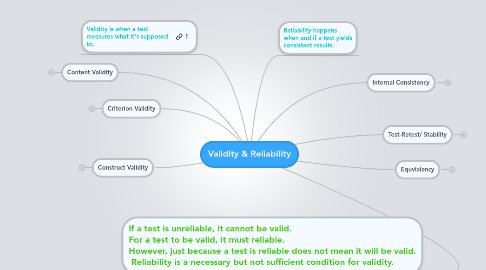
1. Validity is when a test measures what it's supposed to.
2. Criterion Validity
2.1. Is the measure consistent with what we already know and what we expect? Two subcategories: predictive and concurrent
2.1.1. Concurrent validity
2.1.1.1. Associated with pre-existing indicators; something that already measures the same concept
2.1.2. Predictive validity
2.1.2.1. Predicts a known association between the construct you’re measuring and something else.
3. Construct Validity
3.1. a test has construct validity if it accurately measures a theoretical, non-observable construct or trait. The construct validity of a test is worked out over a period of time on the basis of an accumulation of evidence. There are a number of ways to establish construct validity.
3.1.1. A test has convergent validity if it has a high correlation with another test that measures the same construct. By contrast, a test’s divergent validity is demonstrated through a low correlation with a test that measures a different construct.
3.1.2. we can asses the test’s internal consistency. That is, if a test has construct validity, scores on the individual test items should correlate highly with the total test score. This is evidence that the test is measuring a single construct
4. Content Validity
4.1. The extent to which a test adequately represents the subject-matter content or behavior to be measured -- commonly used in evaluating achievement or proficiency tests.
4.1.1. Example: a comprehensive math achievement test would lack content validity if good scores depended primarily on knowledge of English, or if it only had questions about one aspect of math (e.g., algebra)
